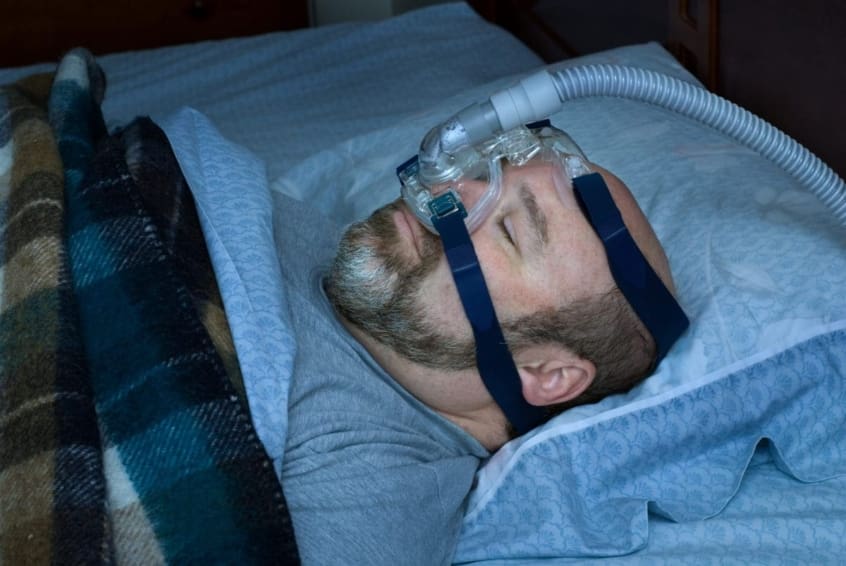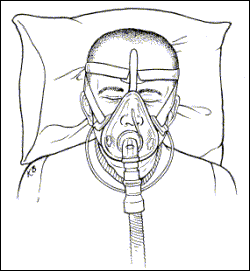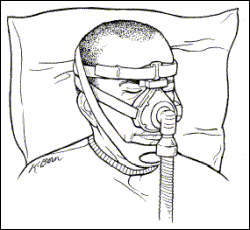
If you suffer from sleep apnea, you know how it can negatively affect your quality of life. This serious sleep disorder may cause you to stop breathing for 10 to 30 seconds at a time while you sleep. It can happen up to 400 times each night. All that lost sleep can affect people of all ages. And it affects them in many ways — from headaches and irritability to more serious complications, such as pulmonary hypertension and even death. See your doctor if you think you have sleep apnea. One treatment device offers hope. It’s called a continuous positive airway pressure (CPAP) device.
Path to improved wellness
A CPAP device fits over your face while you sleep. It includes a mask, tubes, and a fan. The mask and tubes are disposable. There are 3 main types of devices: the nasal pillow model, the nasal mask, and the full-face mask.
A CPAP uses air pressure to push your tongue forward and open your throat. This allows air to pass through your throat. It reduces snoring and prevents sleep disturbances. Your doctor may prescribe a CPAP device after discussing your symptoms and health history. He or she may have you complete a sleep study as well. You may begin with an at-home sleep study. If this study reveals that you have sleep apnea, your doctor may suggest an overnight test at a sleep study facility. Here, you participate in the study with trained clinical professionals who use technology to monitor your overnight sleep. The results from this study will be used to “program” or calibrate your CPAP machine. If your doctor prescribes a CPAP, you should wear it whenever you sleep, even for naps. If you are significantly overweight or suffer from severe apnea, your CPAP may require higher air pressure.
While a CPAP will not cure sleep apnea, it will help you get a restful night’s sleep. Specific benefits include:
- Improved daytime concentration and memory.
- More energy during the day.
- Your bed partner’s improved sleep.
- Improved productivity at work.
- Reduced anxiety and depression.
- Regular sleep patterns.
- Lower blood pressure if your blood pressure is normally high.
Types of CPAP Devices

Nasal pillows

Face mask

Face mask with chin strap
Things to consider
Some people have problems with their CPAP device. This is more common when they first start using it. If you have problems at first, don’t give up. Many times, the problems go away as you get used to wearing the device. It also may be helpful to find a support group in your area so you can talk with others who use the device.
Other common concerns with a CPAP include:
- You may need to try different shapes to find the one that is right for you.
- Dry, stuffy nose. Use a humidifier to moisten the air from your CPAP device. Using a nasal gel or nasal saline before bed can improve dryness. If very stuffy, consider using a saline nasal spray then a nasal steroid spray to reduce nasal congestion. This will improve nasal air flow.
- Blocked nose. Some people who have sleep apnea also have nose problems. Talk to your doctor to see if your nose can be treated with a nasal spray. Surgery is sometimes an option, too. People who breathe through their mouths don’t do as well with CPAP nose masks. A full-face mask may be a better option.
- Skin and nose irritation. This may occur because the device must fit firmly over your nose and cheeks. A different kind or size of mask may help. Also, there are special skin moisturizers made for CPAP device users. Some lotions can damage the mask. Ask your doctor for more information. People who suffer from skin and nose irritation choose to wear the nasal pillow model that fits into the nose and relieves pressure on the bridge of the nose. Consider alternating between the nasal model and the regular mask for comfort.
- Air leaks. Some people can’t keep their jaw closed while wearing the mask. A chin strap can help with this and keep the air from leaking
- Pressure problems. Sometimes the pressure bothers people. This occurs when they you breathe out as the air blows in. Your doctor may suggest using a bi-level device that lowers the air pressure as you breathe out.
- Some people have trouble wearing the mask all night, every night. Keep trying. Start with an hour at a time. Once you get comfortable, you can increase your time.
- Tongue discomfort. Some people find that wearing a dental device that pushes the tongue forward makes the mask more comfortable. A more serious solution may involve throat or jaw surgery. Talk to your doctor about your discomfort.
Questions to ask your doctor
- If I share a bed or room at night, how can I tell if the other person has sleep apnea?
- Is the device expensive and covered by insurance?
- Can you sleep on your side with the mask?
- If the fan on the device breaks, is that harmful to your health?
- Is the CPAP beneficial for other health conditions?
- Should I bring the CPAP device with me when I travel?
Resources
National Institutes of Health, MedlinePlus: Positive Airway Pressure Treatment
![]()
Copyright © American Academy of Family Physicians
This information provides a general overview and may not apply to everyone. Talk to your family doctor to find out if this information applies to you and to get more information on this subject.







